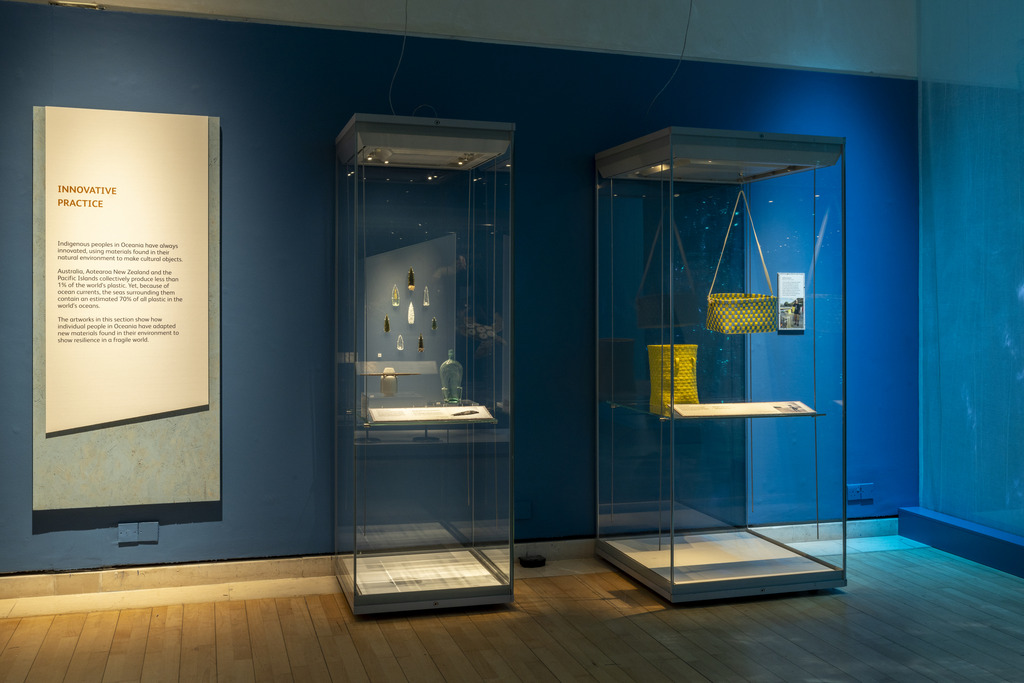National Museums Scotland
Rising Tide: Art and Environment in Oceania
In August 2023, Rising Tide: Art and Environment in Oceania opened at the National Museum of Scotland. The exhibition considers how life depends on the ocean and presents various ways in which individuals within Oceania are working to protect it through the medium of artistic practice.
From the start, we wanted the design, build and procurement of this exhibition to draw on the principles of Rising Tide. We wanted to have the least impact on our environment and minimise inclusion of single-use plastics.
National Museums Scotland is committed to a sustainability strategy, so that by 2030:
‘We will be well advanced on the path to net zero carbon and a respected resource for understanding climate and biodiversity challenges.’
Within our exhibitions we strive to reduce and reuse materials wherever possible, and are continually increasing our collective knowledge with regard to sustainable alternatives by testing new materials and working with contractors.
Where possible, we looked to reuse elements for the build.
Our fit-out contractor had just taken down a wooden theatre set which was going spare. We managed to creatively source a lot of the build from this – all they needed to do was it chop it up and paint it blue. It means that most of the wooden elements in the exhibition are already on their second life.
When we needed to buy new, we looked to source build items that would have multiple lives in the museum.
When displaying objects inside the cases, we bought a set of standard-sized glass shelves which we will be able to use in future exhibitions.
We tried to ensure that, where possible, we used sustainable, recycled and recyclable materials for the exhibition graphics.
Our main section introduction panels are made with a base of recycled wood composite, with a white-lined honeycomb recycled cardboard panel on top. We have left the edges of the cardboard exposed, so it is obvious to the visitor what it is made of.
We aimed to work with contractors who use sustainable methods and look to minimise the carbon emissions and environmental impact of the work they do.
All interested companies were assessed on their sustainability credentials, both in general and on specific actions they would take for this project. For example, the company we worked with on the exhibition AVs have a ‘no-fly’ policy. They are based in Glasgow and London, with an international network of contacts and are committed to travelling sustainably. This meant that when they needed to film one of the exhibition artists in France, they used their network of international contacts to get a local crew on board.
We considered the afterlife of the exhibition and the materials that couldn’t be reused.
The materials we used for the graphics have largely come from a UK-based company, who use water-free printing processes, make and use recycled materials, and offer a ‘closed loop’ system to their clients. This means they will take back products after use and recycle them where the client is unable to. The materials we are using are also very lightweight and were delivered by a carbon-neutral courier with a fleet of electric vehicles. All the packaging was recyclable too.

Our exhibitions and design team have developed a detailed spreadsheet to track the carbon cost involved in creating exhibitions. Anything that is paid for from the exhibition budget is logged in this spreadsheet. This includes all materials purchased, and the freight or delivery of getting them to the museum.
It also includes travel and accommodation, either by staff during exhibition research and development, or contractors travelling to the museum to carry out work. The carbon information gathered during Rising Tide is now helping shape the procurement process for subsequent exhibitions.
A major challenge for a museum like ours is finding sustainable materials that are safe to use inside object show cases. We test any new materials that will be used inside cases to ensure that the material will not affect the objects on display.
For the object labels in the exhibition, we found a 100% recycled and 100% recyclable material made of waste plastic from items such as refrigerators. It is also manufactured using 100% renewable energy, is carbon neutral, and is designed to have the lowest ecological impact possible. Unfortunately, this material did not pass the testing requirements for the exhibition, and we used a honeycomb recycled cardboard which did pass tests instead.
Cost of sustainable materials is another major challenge we’ve faced, as the environmentally friendly alternatives can often be beyond the scope of our budgets.
We would recommend that other museums hoping to follow a similar approach should embed a sustainable methodology within the development of an exhibition from the start – so sustainable materials and processes can be identified as early in the development process as possible, and budget can be allocated to achieving sustainability in more challenging areas.
For the most part, this is the most environmentally friendly exhibition we have ever delivered, which is highly appropriate to this exhibition’s subject matter and aligns with our strategic goals of both reducing our own carbon outputs while raising public awareness and engagement with themes of climate change and biodiversity loss. We hope it helps pave the way for more planet-conscious exhibition design in the future.
By Ali Clark, senior curator – Oceania, Jan Dawson, 3D designer, and Declan Duffy, exhibitions and displays officer. You can learn more about National Museums Scotland’s wider approach and responses to sustainability, climate and biodiversity loss by reading its vision for sustainability.
Main image: Reused wooden elements. Copyright National Museums Scotland